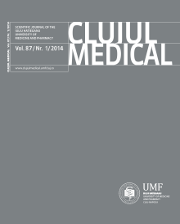Suckling and Non-nutritive Sucking Habit: What Should we Know?
DOI:
https://doi.org/10.15386/cjm.2014.8872.871.df1mg2Keywords:
suckling, malocclusion, non-nutritive sucking-habit, infant swallowing, adult-type swallowingAbstract
Correct breast feeding can be considered a tool for the post-natal prophylaxis of craniofacial abnormalities, or at least a way of reducing their extent.
Inadequate bottle feeding forces the tongue and cheek muscles to develop a compensating and atypical function, in order to obtain the milk. As a result, there can be an adaptation change of the dental and bone structures, leading to malocclusions.
Finger-sucking is normal in the first two-three years of life. It gives the child a feeling of relaxation; that is why it is usually practiced before sleeping. The effects of non-nutritive sucking on the developing dentition are minor in the child under 3 years of age and are usually limited to changes in the incisor position. Some upper or lower incisors (depend on how the finger has been sucked) become spontaneously tipped toward the lips, and/or others are prevented from erupting. Normally children abandon this habit between 2 and 4 years of age. If it persists after this age, it will be the cause for some dental-maxillary anomalies: open-bite, narrow maxilla with upper protrusion, cross-bite; all these could be accompanied by retrognathic mandible.
Downloads
Published
How to Cite
Issue
Section
License
The authors are required to transfer the copyright of the published paper to the journal. This is done by agreeing to sign the Copyright Assignment Form. Whenever the case, authors are also required to send permissions to reproduce material (such as illustrations) from the copyright holder.

The papers published in the journal are licensed under a Creative Commons Attribution-NonCommercial-NoDerivatives 4.0 International License.

